The car can be equipped with a starter 42.3708 or 4211.3708-01 or 62.3708
Starters have almost the same design
The starter is a four-pole, four-brush, mixed-excitation DC motor with a two-winding electromagnetic traction relay
The starter is attached to the clutch housing with two studs
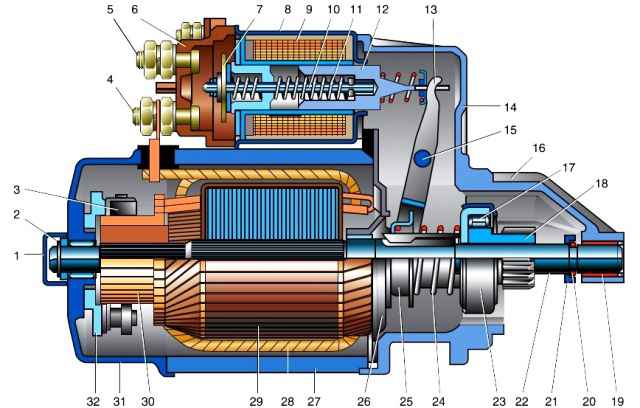
Starter: 1 - protective cap; 2 - locking washer; 3 - brush; 4, 5 - conclusions; 6 - cover of the traction relay; 7 - contact plate; 8 - traction relay; 9 - relay winding; 10 - stock; 11 - return spring; 12 - core; 13 - lever; 14 - front cover; 15 - axis of the lever; 16 - cover extension; 17 - roller; 18 - drive (drive) gear; 19 - bushing; 20 - spring ring; 21 - thrust bushing; 22 - shaft; 23 - overrunning clutch; 24 - spring; 25 - coupling half; 26 - intermediate support; 27 - stator; 28 - stator winding; 29 - rotor (anchor); 30 - collector; 31 - back cover; 32 - brush holder
Technical characteristics of starter 42.3708:
- Rated voltage, V 12
- Rated power, kW 1.7
- Consumed current at maximum power, no more than, A 700
- Consumed current in idle mode, no more than, A 80
- Torque, not less than, kgf.m 1.6
The starter housing and covers are tightened with two bolts
The front and rear covers are equipped with bronze-graphite plain bearings (bushings) in which the armature shaft rotates
An overrunning clutch with a drive gear is installed on the armature shaft
The clutch transmits torque in only one direction - from the starter to the engine, separating them after starting the engine
This is to protect the starter motor from damage due to overspeed
The traction relay is used to engage the drive gear with the ring gear of the engine crankshaft flywheel and turn on the power to the starter motor.
When the ignition key is turned to the “starter” position, voltage is applied to both windings of the traction relay (retractor and hold).
After closing the contacts of the traction relay, the retractable winding is turned off.
The relay operation voltage must be at least 8V at 20 °С.
The serviceability of the drive is determined by external inspection after disassembling the starter
The stator, rotor and traction relay are checked for a short circuit (or open) of the windings, faulty components are replaced as an assembly
External inspection checks the condition of the collector and brushes - worn brushes are replaced, the oily collector is degreased with white spirit or gasoline
Removing the starter
Install the car on the inspection ditch
Disconnect the negative battery terminal
Remove the insulating cap of the control wire tip
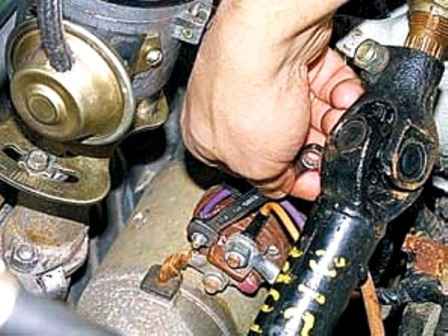
We unscrew the nut of the wire fastening with a key 8 and remove it from the output of the winding of the traction relay
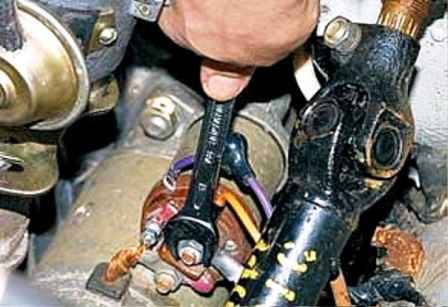
Using a 13 key, unscrew the traction relay output nut
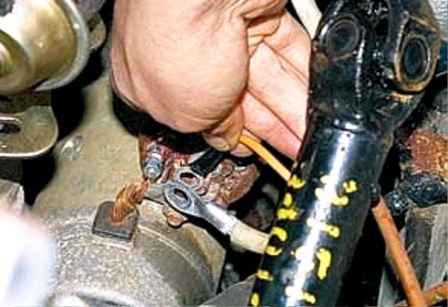
Remove the tips of the two wires from the output

With a 12 head, we unscrew the two bolts securing the clutch slave cylinder
The cylinder is laid on the braided wire of the engine ground
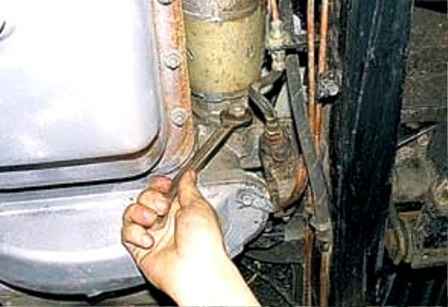
We unscrew the bottom nut of the starter fastening with a wrench 19

Unscrew the top starter nut
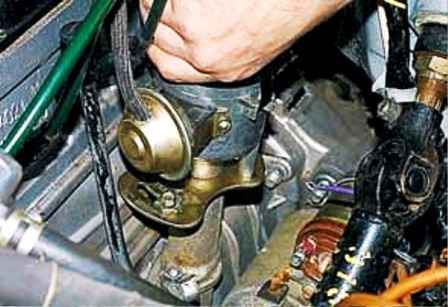
We loosen the octane-corrector bolt and, marking its position on the scale, turn it so that the octane-corrector plate does not interfere with removing the starter

Remove the starter
Install the starter in reverse order
Possible starter malfunctions and troubleshooting
When the starter is turned on, the armature does not rotate
- Violation of contact between the brushes and the commutator
Remove the starter from the engine, disassemble it and eliminate the cause of the malfunction
- Lack of contact in the starter traction relay
Disconnect the wires from the starter, remove the relay cover. If the contacts are burnt, clean them. Rotate heavily burnt contacts 180° around the axis
- Breakage of connections inside the starter or in the traction relay
Replace starter
- Lack of reliable contact in the ignition switch (lock) at the output: "St" - for UAZ-3151, UAZ-31512 or "50" - for UAZ-31514, UAZ-31519
Check the circuit with a test lamp connected to terminal St (50) and ground.
If there is no power at terminal "St" (50) in the position corresponding to the starter being turned on, replace the ignition switch
- Open winding or burning of contacts in an additional relay
Check the circuit with a test lamp.
The lamp connected to terminal "87" of the additional relay and "ground" should light up when turned on
starter. If the lamp does not light, then disassemble the relay, clean the contacts
- Armature sticking in the electromagnet coil sleeve
Clean armature, relay and bushing.
If there is a displacement of the traction relay relative to the lever, replace the starter
When the starter is turned on, the engine crankshaft does not rotate or rotates at a low frequency
- Discharged or defective battery
Check the battery and replace if necessary
- Short circuit of the armature or excitation coil or touching of the armature by the poles
Replace parts or starter
- Tight cranking of the engine crankshaft
In the cold season, use oil of the appropriate viscosity
- Violation of the starter power circuit due to poor tightening of the wire ends
Inspect the starter power circuit, tighten all clamps
- Severe bearing wear
Replace bearings or starter
When turned on, the starter shaft rotates at a higher speed, but does not turn the engine shaft
- Breakage of the teeth of the flywheel crown
Replace crown or flywheel
- Slip of the freewheel roller clutch
Replace starter drive
When the starter is turned on, a repeated strong knock of the traction relay and gear on the ring is heard, while the crankshaft does not turn
- there is no reliable contact in the battery clamps
Tighten clamp bolts
- Discharged or defective battery
Check, recharge or replace the battery
- The holding winding of the traction relay is faulty or its contact with the "ground" is broken
Replace or ensure good winding contact
After starting the engine, the starter does not turn off
- Drive stuck on the armature shaft
Replace drive
- Sintering the contact for turning on the traction relay or additional relay
Troubleshoot or replace parts





